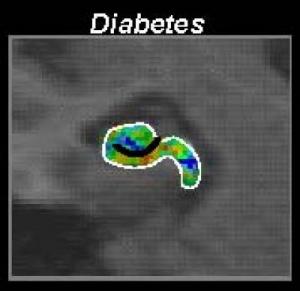
© Columbia University Medical CenterCerebral blood volume (CBV) maps are shown for a subject with diabetes. Maps are color-coded with warmer colors indicating greater CBV or activity.
Maintaining blood sugar levels, even in the absence of disease, may be an important strategy for preserving cognitive health, suggests a study published by researchers at Columbia University Medical Center (CUMC).
Senior moments, also dubbed by
New York Times Op-Ed columnist David Brooks as being "hippocampically challenged," are a normal part of aging. Such lapses in memory, according to this new research, could be blamed, at least in part, on rising blood glucose levels as we age. The findings suggest that exercising to improve blood sugar levels could be a way for some people to stave off the normal cognitive decline that comes with age.
"This is news even for people without diabetes since blood glucose levels tend to rise as we grow older. Whether through physical exercise, diet or drugs, our research suggests that improving glucose metabolism could help some of us avert the cognitive slide that occurs in many of us as we age," reported lead investigator Scott A. Small, M.D., associate professor of neurology in the Sergievsky Center and in the Taub Institute for Research on Alzheimer's Disease and the Aging Brain at Columbia University Medical Center.
